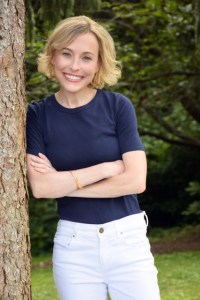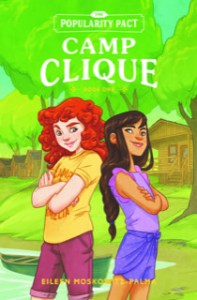I met Mae Respicio when our debut middle-grade novels released in the same year, 2018, and I was so impressed with her as an author and a person. Now Mae has a brand new MG coming out, ANY DAY WITH YOU. The novel got a starred review from Publishers Weekly and will be on shelves in just a couple weeks, on May 5, published by Wendy Lamb Books, an imprint of Penguin Random House.
Mae is a star at working themes into her writing, so I’m thrilled that she’s on The Mixed Up Files to talk to us about that today.
Hi, Mae, tell us about your new MG book!
Of course—and thanks for having me here—I can’t wait to share ANY DAY WITH YOU with readers! The story revolves around twelve-year-old Kaia, who loves the beach, making movies, and creating effects make-up. When Kaia’s ninety-year-old great grandpa, Tatang, decides to return to his homeland of the Philippines, she doesn’t want him to go. Kaia and her best friends make a movie about the Filipino folklore Tatang loves to tell, and they enter it into a summer film contest thinking that if they win, it’ll stop him from saying goodbye. The book is all about family, friendship, and how we navigate change… an early reader told me she thought it was the warm hug we could all use right now and I love that—it’s a feel-good book for these times.
What gave you the idea for this story?
ANY DAY WITH YOU has a lot of personal connections for me. It’s set in sunny beachside Los Angeles, one of my heart-homes where I lived for many years. It has a filmmaking element, which is a world I’ve been a part of (fun fact: I met my husband when we both worked for the Walt Disney Animation Studios, and he did the teeniest bit of interior art for the book!). The story also features “maker-kids”—I’ve got 2 at home!—and as a girl I always loved to draw and create things. Finally, Tatang’s storyline came to be because it’s loosely inspired by my childhood—my grandparents lived with my family for a little while, so intergenerational relationships played a big role in my life. Somehow I combined all these elements and Kaia’s story was born.
ANY DAY WITH YOU has some great themes. Tell us about them.
One of the main themes of ANY DAY WITH YOU is around resiliency: what happens when your life changes, and how do you choose to deal with it? In this very moment our whole world is connected by change, and we’re all learning how to deal with it through empathy, kindness, and patience. It’s timely and a perfect book for kids right now, especially if teachers and parents can gently guide readers through conversations of how we navigate change to make us stronger.
Do you develop your themes when you’re first working on a story or do you identify them later in the process?
 I usually brainstorm with certain themes in mind, but they start off big and overarching until I get to know my characters—that’s when I can get more nuanced. For ANY DAY WITH YOU, I wanted to explore “resiliency”—but I didn’t know what that meant until I came up Tatang’s storyline. That also happened with THE HOUSE THAT LOU BUILT. I wanted to write around “dreaming big” and “persistence,” but I didn’t know what that looked like until I came up with details of a girl wanting to build her own tiny house. When developing themes, I try to answer questions around what choices and obstacles would be thrown my characters way, and what emotions I want readers to come away with.
I usually brainstorm with certain themes in mind, but they start off big and overarching until I get to know my characters—that’s when I can get more nuanced. For ANY DAY WITH YOU, I wanted to explore “resiliency”—but I didn’t know what that meant until I came up Tatang’s storyline. That also happened with THE HOUSE THAT LOU BUILT. I wanted to write around “dreaming big” and “persistence,” but I didn’t know what that looked like until I came up with details of a girl wanting to build her own tiny house. When developing themes, I try to answer questions around what choices and obstacles would be thrown my characters way, and what emotions I want readers to come away with.
How do you use themes to dig deeper in your work?
Honestly, I don’t think about digging deep when I’m writing a first draft. I start off with a general story line—a beginning, middle, and end—then I let it all come out however messy… usually my first drafts look like a massive pile of words that make no sense! Revision is when I can dig deep, and that’s where a story’s richness comes in. For me that means using specific images, actions, and character choices that keep relating back the book’s themes. In ANY DAY WITH YOU, there’s some ocean and nature imagery relating to resiliency—so for example, showing how waves change daily but still they roll in a regular rhythm, a bit the way humans keep going even when their lives are disrupted.
Writers often explore similar themes in their body of work. Did you find that ANY DAY WITH YOU had similar themes to your earlier MG book THE HOUSE THAT LOU BOOK?
 Oh, definitely. I’ve also published a lot of nonfiction and personal essay, and what I’ve found is that in most things I write there’s some thread of “home”—how do we discover home and what does that mean based on our different lenses.
Oh, definitely. I’ve also published a lot of nonfiction and personal essay, and what I’ve found is that in most things I write there’s some thread of “home”—how do we discover home and what does that mean based on our different lenses.
Are there other parts of the book where you pulled from your own experiences?
My fiction has a balance of what I don’t know (and want to learn more about), and what I know intrinsically and what I’ve lived—usually from childhood—which is the part I think adds layer and spark. Also, as a parent of middle-grade reading kids, I draw from my parenting life—an endless, funny bounty of honest fodder. I grew up going to California beaches and it’s the way my family enjoys spending time together (my kids surf and love all beachy things!), so it was a fun writing exercise pulling from childhood memories and family experiences around the smells, sounds, and feeling of being near the ocean.
When does ANY DAY WITH YOU come out and how will you be celebrating?
ANY DAY WITH YOU comes out May 5th and I’ll be celebrating from home while sheltering in place! This may involve a cake and pajamas. Okay, maybe not PJs if I end up filming a little celebration video and sharing it online, but obviously there will be cake. Folks can follow me on Twitter and Instagram—or sign up for my (very infrequent!) newsletter—where I’ll be shouting out upcoming events.
Thanks, Mae! I’ve learned so much.
You can pre-order ANY DAY WITH YOU now.







 Begin by putting your pencil down in the middle of your paper; after that, do not look at your paper. You will be creating a wandering scribble — not a drawing of the item. Resist the temptation to look at your paper! As you watch your imaginary ant explore, trace his trail on the paper, basically creating a map of his route. Keep your ant going. Keep your dominant hand tracing. Make your ant go around the corner, over the edge, into the hole.
Begin by putting your pencil down in the middle of your paper; after that, do not look at your paper. You will be creating a wandering scribble — not a drawing of the item. Resist the temptation to look at your paper! As you watch your imaginary ant explore, trace his trail on the paper, basically creating a map of his route. Keep your ant going. Keep your dominant hand tracing. Make your ant go around the corner, over the edge, into the hole.
 Now, let’s take this exercise a bit further. We won’t try to find a universal truth here (although you might try that too), but instead practice with a simpler task, creating mood. Skim your list for descriptors that convey a common mood. In my list, several feel kind of ominous. Using a highlighter, crayon or symbol, mark the details that match the mood. I’ve chosen yellow for ominous ones. Next, search your list for a different mood and mark that with a different color. Can you find a third?
Now, let’s take this exercise a bit further. We won’t try to find a universal truth here (although you might try that too), but instead practice with a simpler task, creating mood. Skim your list for descriptors that convey a common mood. In my list, several feel kind of ominous. Using a highlighter, crayon or symbol, mark the details that match the mood. I’ve chosen yellow for ominous ones. Next, search your list for a different mood and mark that with a different color. Can you find a third?
 Eileen Moskowitz-Palma and I first crossed paths more than a decade ago, at the Backspace Writers Conference, in New York. I can’t remember which panels I attended, but one thing stands out: meeting Eileen. We were sitting in a large, well-lit room, waiting for the keynote to begin, when she turned around and smiled at me. It was the warmest, friendliest smile I had ever seen, and naturally I wanted to bask in her… Eileen-ness.
Eileen Moskowitz-Palma and I first crossed paths more than a decade ago, at the Backspace Writers Conference, in New York. I can’t remember which panels I attended, but one thing stands out: meeting Eileen. We were sitting in a large, well-lit room, waiting for the keynote to begin, when she turned around and smiled at me. It was the warmest, friendliest smile I had ever seen, and naturally I wanted to bask in her… Eileen-ness.
 MR: Camp Amelia is an adventure camp, with the focus on team spirit and athletic ability. There’s even a camp-wide sports competition (“the Cup”), where winning is everything. Were you sporty like Bea, or anxious like Maisy? Perhaps an amalgam of both?
MR: Camp Amelia is an adventure camp, with the focus on team spirit and athletic ability. There’s even a camp-wide sports competition (“the Cup”), where winning is everything. Were you sporty like Bea, or anxious like Maisy? Perhaps an amalgam of both?